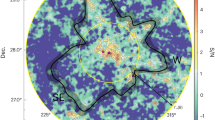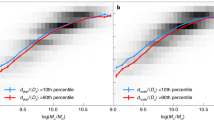Abstract
Galaxy redshift surveys, such as the 2-Degree-Field Survey (2dF)1, Sloan Digital Sky Survey (SDSS)2, 6-Degree-Field Survey (6dF)3, Galaxy And Mass Assembly survey (GAMA)4 and VIMOS Public Extragalactic Redshift Survey (VIPERS)5, have shown that the spatial distribution of matter forms a rich web, known as the cosmic web6. Most galaxy survey analyses measure the amplitude of galaxy clustering as a function of scale, ignoring information beyond a small number of summary statistics. Because the matter density field becomes highly non-Gaussian as structure evolves under gravity, we expect other statistical descriptions of the field to provide us with additional information. One way to study the non-Gaussianity is to study filaments, which evolve non-linearly from the initial density fluctuations produced in the primordial Universe. In our study, we report the detection of lensing of the cosmic microwave background (CMB) by filaments, and we apply a null test to confirm our detection. Furthermore, we propose a phenomenological model to interpret the detected signal, and we measure how filaments trace the matter distribution on large scales through filament bias, which we measure to be around 1.5. Our study provides new scope to understand the environmental dependence of galaxy formation. In the future, the joint analysis of lensing and Sunyaev–Zel’dovich observations might reveal the properties of ‘missing baryons’, the vast majority of the gas that resides in the intergalactic medium, which has so far evaded most observations.
This is a preview of subscription content, access via your institution
Access options
Access Nature and 54 other Nature Portfolio journals
Get Nature+, our best-value online-access subscription
$29.99 / 30 days
cancel any time
Subscribe to this journal
Receive 12 digital issues and online access to articles
$119.00 per year
only $9.92 per issue
Buy this article
- Purchase on Springer Link
- Instant access to full article PDF
Prices may be subject to local taxes which are calculated during checkout



Similar content being viewed by others
References
Colless, M. et al. The 2dF galaxy redshift survey: spectra and redshifts. Mon. Not. R. Astron. Soc. 328, 1039–1063 (2001).
Eisenstein, D. J. et al. SDSS-III: massive spectroscopic surveys of the distant universe, the Milky Way galaxy, and extra-solar planetary systems. Astron. J. 142, 72 (2011).
Jones, H. D. et al. The 6dF galaxy survey: final redshift release (DR3) and southern large-scale structures. Mon. Not. R. Astron. Soc. 399, 683–698 (2009).
Liske, J. et al. Galaxy and mass assembly (GAMA): end of survey report and data release 2. Mon. Not. R. Astron. Soc. 452, 2087–2126 (2015).
Scodeggio, M. et al. The VIMOS Public Extragalactic Redshift Survey (VIPERS). Full spectroscopic data and auxiliary information release (PDR-2). Astron. Astrophys. 609, A84 (2018).
Bond, R. J., Kofman, L. & Pogosyan, D. How filaments are woven into the cosmic web. Nature 380, 603–606 (1996).
Smith, K. M., Zahn, O. & Dore, O. Detection of gravitational lensing in the cosmic microwave background. Phys. Rev. D 76, 043510 (2007).
Hirata, C. M., Ho, S., Padmanabhan, N., Seljak, U. & Bahcall, N. A. Correlation of CMB with large-scale structure: II. Weak lensing. Phys. Rev. D 78, 043520 (2008).
Bleem, L. E. et al. A measurement of the correlation of galaxy surveys with CMB lensing convergence maps from the South Pole Telescope. Astron. J. 753, L9 (2012).
Sherwin, B. D. et al. The Atacama Cosmology Telescope: cross-correlation of CMB lensing and quasars. Phys. Rev. D 86, 083006 (2012).
Ferraro, S., Sherwin, B. D. & Spergel, D. N. WISE measurement of the integrated Sachs–Wolfe effect. Phys. Rev. D 91, 083533 (2015).
Allison, R. et al. The Atacama Cosmology Telescope: measuring radio galaxy bias through cross-correlation with lensing. Mon. Not. R. Astron. Soc. 451, 849–858 (2015).
Giannantonio, T. et al. CMB lensing tomography with the DES Science Verification galaxies. Mon. Not. R. Astron. Soc. 456, 3213–3244 (2016).
Pullen, A. R., Alam, S., He, S. & Ho, S. Constraining gravity at the largest scales through CMB lensing and galaxy velocities. Mon. Not. R. Astron. Soc. 460, 4098–4108 (2016).
Doux, C. et al. First detection of cosmic microwave background lensing and Lyman-α forest bispectrum. Phys. Rev. D 94, 103506 (2016).
Singh, S., Mandelbaum, R. & Brownstein, J. R. Cross-correlating Planck CMB lensing with SDSS: lensing–lensing and galaxy–lensing cross-correlations. Mon. Not. R. Astron. Soc. 464, 2120–2138 (2017).
Geach, E. G. & Peacock, J. A. Cluster richness-mass calibration with cosmic microwave background lensing. Nat. Astron. 1, 795–799 (2017).
Chen, Y. et al. Cosmic web reconstruction through density ridges: catalogue. Mon. Not. R. Astron. Soc. 461, 3896–3909 (2016).
Dawson, K. S. et al. The Baryon Oscillation Spectroscopic Survey of SDSS-III. Astron. J. 145, 10 (2013).
Alam, S. et al. The eleventh and twelfth data releases of the Sloan Digital Sky Survey: final data from SDSS-III. Astron. J. Suppl. 219, 12 (2015).
Chen, Y., Ho, S., Freeman, P. E., Genovese, C. R. & Wasserman, L. Cosmic web reconstruction through density ridges: method and algorithm. Mon. Not. R. Astron. Soc. 454, 1140–1156 (2015).
Planck Collaboration. Planck 2013 results. I. Overview of products and scientific results. Astron. Astrophys. 571, A1 (2014).
Planck Collaboration. Planck 2013 results. XVII. Gravitational lensing by large-scale structure. Astron. Astrophys. 571, A17 (2014).
Clampitt, J., Jain, B., Takada, M. & Miyatake, H. Detection of stacked filament lensing between SDSS luminous red galaxies. Mon. Not. R. Astron. Soc. 457, 2391–2400 (2016).
Epps, S. D. & Hudson, M. J. The weak lensing masses of filaments between luminous red galaxies. Mon. Not. R. Astron. Soc. 468, 2605–2613 (2017).
Higuchi, Y., Oguri, M. & Shirasaki, M. Statistical properties of filaments in weak gravitational lensing. Mon. Not. R. Astron. Soc. 441, 745–756 (2014).
Planck Collaboration. Planck 2013 results. XVI. Cosmological parameters. Astron. Astrophys. 571, A16 (2014).
Limber, D. N. The analysis of counts of the extragalactic nebulae in terms of a fluctuating density field. Astrophys. J. 117, 134 (1953).
Rykoff, E. S. et al. redMaPPer I: Algorithm and SDSS DR8 Catalog. Astron. J. 785, 104 (2014).
de Graaff, A., Cai, Y. C., Heymans, C. & Peacock, J. A. Missing baryons in the cosmic web revealed by the Sunyaev–Zel’dovich effect. Preprint at https://arxiv.org/abs/1709.10378 (2017).
Wassermann, L. All of Nonparametric Statistics (Springer Science and Business Media, New York, USA, 2017).
Chen, Y. et al. Detecting effects of filaments on galaxy properties in the Sloan Digital Sky Survey III. Mon. Not. R. Astron. Soc. 466, 1880–1893 (2017).
Chen, Y. C., Genovese, C. R. & Wasserman, L. Asymptotic theory for density ridges. Ann. Statistics 43, 1896–1928 (2015).
Bagla, J. S. A TreePM code for cosmological N-body simulations. Astron. Astrophys. 23, 185–196 (2002).
White, M. J., Hernquist, L. & Springel, V. Simulating the Sunyaev–Zel’dovich effect(s): Including radiative cooling and energy injection by galactic winds. Astron. J. 579, 16 (2002).
Reid, B. A., Seo, H., Leauthaud, A., Tinker, J. L. & White, M. A 2.5 per cent measurement of the growth rate from small-scale redshift space clustering of SDSS-III CMASS galaxies. Mon. Not. R. Astron. Soc. 444, 476–502 (2014).
Peacock, J. A. & Smith, R. E. Halo occupation numbers and galaxy bias. Mon. Not. R. Astron. Soc. 318, 1144–1156 (2000).
Seljak, U. Analytic model for galaxy and dark matter clustering. Mon. Not. R. Astron. Soc. 318, 203–213 (2000).
Benson, A. J., Cole, S., Frenk, C. S., Baugh, C. M. & Lacey, C. G. The nature of galaxy bias and clustering. Mon. Not. R. Astron. Soc. 311, 793–808 (2000).
White, M. J., Hernquist, L. & Springel, V. The halo model and numerical simulations. Astron. J. 550, 129–132 (2001).
Berlind, A. A. & Weinberg, D. H. The Halo occupation distribution: towards an empirical determination of the relation between galaxies and mass. Astron. J. 575, 587–616 (2002).
Cooray, A. & Sheth, R. K. Halo models of large scale structure. Phys. Rept. 372, 1–129 (2002).
Beutler, F. et al. The clustering of galaxies in the SDSS-III Baryon Oscillation Spectroscopic Survey: testing gravity with redshift-space distortions using the power spectrum multipoles. Mon. Not. R. Astron. Soc. 443, 1065–1089 (2014).
White, M., Tinker, J. L. & McBride, C. K. Mock galaxy catalogues using the quick particle mesh method. Mon. Not. R. Astron. Soc. 437, 2594–2606 (2014).
Carlson, J. & White, M. Embedding realistic surveys in simulations through volume remapping. Astron. J. Suppl. 190, 311–314 (2010).
Acknowledgements
We thank A. Pullen and E. Giusarma for discussion, M. White for providing us with the N-body simulations, and A. Krolewski and B. Horowitz for comments on the draft. S. Ho is supported by NASA and DOE for this work. S. He is supported by NSF-AST1517593 for this work. S.A. is supported by the European Research Council through the COSFORM Research Grant (#670193). S.F. thanks the Miller Institute for Basic Research in Science at the University of California, Berkeley for support. Some of the results in this paper have been derived using the HEALPix package. The authors would like to acknowledge the support of NERSC.
Author information
Authors and Affiliations
Contributions
S. He led the project and most of the manuscript writing. S.A. provided the sky mocks for galaxies and dark matter particles as well as wrote the text relative to sky mock for Filaments and Dark Matter in the Method section. S.F. helped with the theoretical modelling and the interpretation of the results, as well as writing part of the manuscript. Y.C. provided the filament intensity maps for data and simulations. S.Ho conceived the idea of cross-correlating filaments with CMB lensing. All authors contributed to the interpretation of the data and commented on the manuscript.
Corresponding author
Ethics declarations
Competing interests
The authors declare no competing interests.
Additional information
Publisher’s note: Springer Nature remains neutral with regard to jurisdictional claims in published maps and institutional affiliations.
Supplementary information
Supplementary Information
Supplementary Figures 1–5
Rights and permissions
About this article
Cite this article
He, S., Alam, S., Ferraro, S. et al. The detection of the imprint of filaments on cosmic microwave background lensing. Nat Astron 2, 401–406 (2018). https://doi.org/10.1038/s41550-018-0426-z
Received:
Accepted:
Published:
Issue Date:
DOI: https://doi.org/10.1038/s41550-018-0426-z



